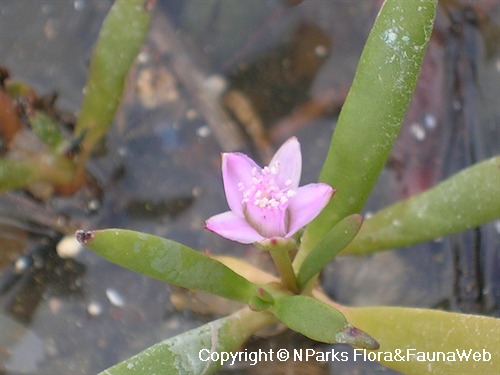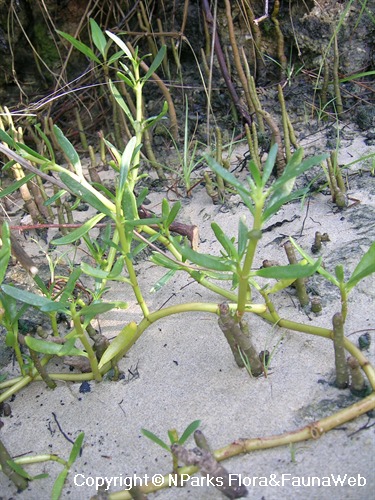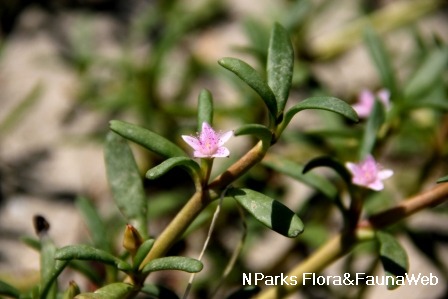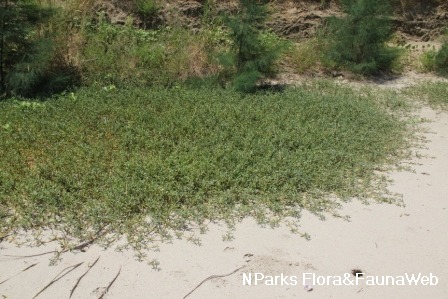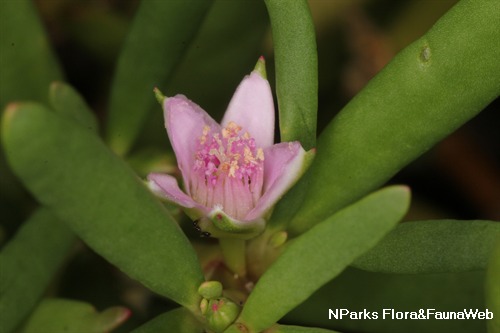
Back
Sesuvium portulacastrum (L.) L.
| Family Name: | Aizoaceae |
| Common Name: | Sea Purslane, Gelang Laut, Gelang Pasir, Saruni Air, 海马齿 |
Name
Classifications and Characteristics
| Plant Division | Angiosperms (Flowering Seed Plants) (Dicotyledon) |
|---|---|
| Plant Growth Form | Creeper, Herbaceous Plant |
| Lifespan (in Singapore) | Perennial |
| Mode of Nutrition | Autotrophic |
Biogeography
| Native Distribution | Pantropical |
|---|---|
| Native Habitat | Terrestrial (Coastal Forest, Disturbed Area / Open Ground), Shoreline (Sandy Beach, Backshore) |
| Preferred Climate Zone | Tropical, Sub-Tropical / Monsoonal |
| Local Conservation Status | Native to Singapore (Least Concern (LC)) |
Description and Ethnobotany
| Growth Form | It is a perennial creeping herb. |
|---|---|
| Foliage | Its opposite, stalked leaves have fleshy blades that are oval or lance-shaped, very succulent, flat above, convex below, and 1.5–5 cm by 2–10 mm. |
| Flowers | Its flower grows singly at the leaf axils, has 5 lobes, is green outside, pink inside, and 8–10 mm long. |
| Fruit | Its fruit is oblong or drop-shaped, 9–11 mm long, and contains shiny, black seeds. |
| Habitat | It grows in saline, clayey, sandy, humid or muddy areas near the sea, and along tidal creeks at sea level. It occurs locally in Pulau Ubin, Pulau Tekong, Pulau Semakau, and at the end of Lim Chu Kang Road. |
| Cultivation | It can be propagated by seed or stem cuttings. |
| Etymology | Latin Sesuvium, land of the Sesuvii, a Gallic tribe, possibly referring to one locality in the natural distribution of this species; Latin portulaca, portulaca-like, referring to its resemblance to members of the Portulaca genus. |
Landscaping Features
| Landscaping | It is suitable as a groundcover for open, sunny areas in parks. |
|---|---|
| Desirable Plant Features | Ornamental Flowers, Ornamental Foliage |
| Landscape Uses | Suitable for Rooftops, Flowerbed / Border, Coastal, Parks & Gardens, Small Gardens, Beachfront / Shoreline, Groundcover |
| Thematic Landscaping | Rockery / Desert Garden, Naturalistic Garden |
Fauna, Pollination and Dispersal
| Pollination Method(s) | Biotic (Fauna) |
|---|---|
| Seed or Spore Dispersal | Abiotic (Explosive Dehiscence, Water) |
Plant Care and Propagation
| Light Preference | Full Sun |
|---|---|
| Water Preference | Moderate Water |
| Plant Growth Rate | Moderate |
| Rootzone Tolerance | Saline Soils / Salt Spray, Drought Tolerant, Shallow Media, Well-Drained Soils, Poor Infertile Soils, Waterlogged Soils, Fertile Loamy Soils, Easy to Grow |
| Maintenance Requirements | Moderate |
| Propagation Method | Seed, Stem Cutting |
Foliar
| Foliage Retention | Evergreen |
|---|---|
| Mature Foliage Colour(s) | Green |
| Mature Foliage Texture(s) | Smooth, Thick |
| Foliar Type | Simple / Unifoliate |
| Foliar Arrangement Along Stem | Opposite |
| Foliar Attachment to Stem | Petiolate |
| Foliar Shape(s) | Non-Palm Foliage (Lanceolate, Linear, Oval) |
| Foliar Margin | Entire |
| Foliar Apex - Tip | Acuminate |
| Typical Foliar Area | Microphyll ( 2.25cm2 - 20.25 cm2 ) |
Non - Foliar and Storage
| Stem Type & Modification | Herbaceous, Runner / Stolon |
|---|---|
| Root Type | Underground (Fibrous Root) |
| Specialised Storage Organ(s) | Aboveground |
Floral (Angiosperm)
| Flower & Plant Sexuality | Bisexual Flowers |
| Flower Colour(s) | Pink |
|---|---|
| Flower Grouping | Solitary |
| Flower Location | Axillary |
| Flower Symmetry | Radial |
| Individual Flower Shape | Stellate / Star-shaped |
| Flowering Habit | Polycarpic |
Fruit, Seed and Spore
| Fruit Classification | Simple Fruit |
|---|---|
| Fruit Type | Dehiscent Dry Fruit , Capsule |
Image Repository
Others
| Master ID | 1163 |
|---|---|
| Species ID | 2456 |
| Flora Disclaimer | The information in this website has been compiled from reliable sources, such as reference works on medicinal plants. It is not a substitute for medical advice or treatment and NParks does not purport to provide any medical advice. Readers should always consult his/her physician before using or consuming a plant for medicinal purposes. |

